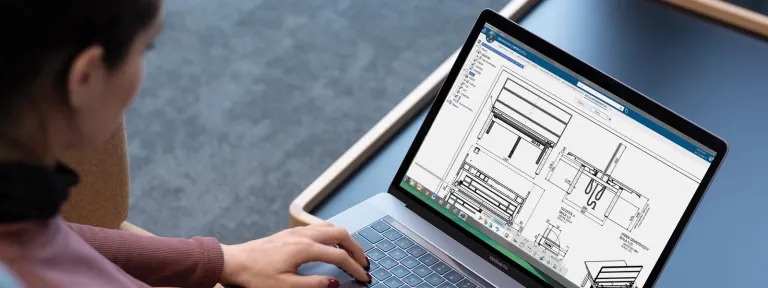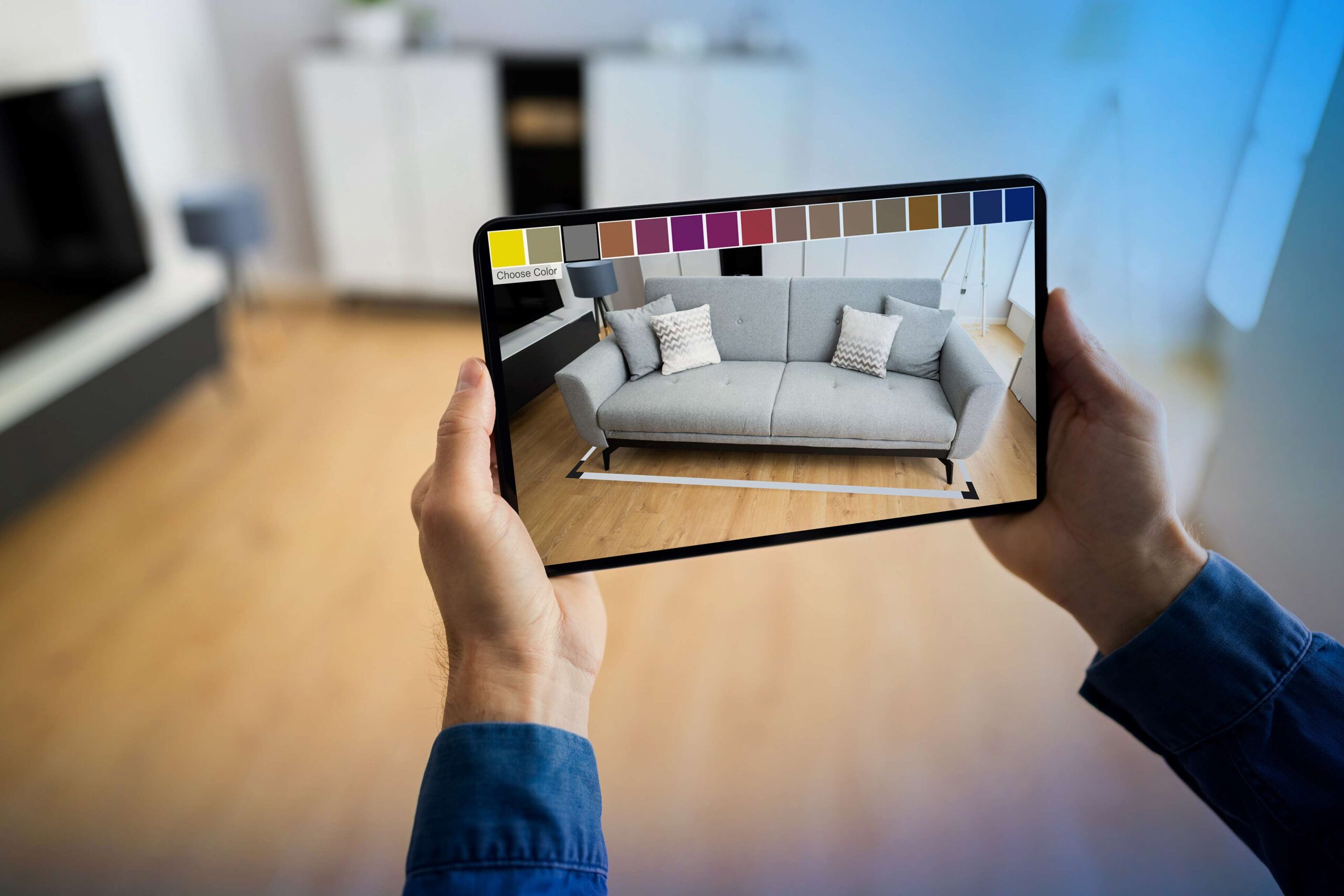As consumers, we don’t always consider what goes into the products we buy. Sure, we might check the origin of a piece of produce or the label on a piece of clothing, but beyond that, its journey to our hands isn’t given much thought. When it comes to something like furniture, though, most of us wouldn’t even be able to imagine what goes into making it.
From the design of a couch or desk to its journey through a factory floor, to a store and into our homes and offices, there’s a common thread: technology. More and more, manufacturers are adopting technological tools, like virtual twins, to enable swift and simple processes. From start to finish, this type of tech can ensure accuracy and efficiency throughout the pipeline.
But it doesn’t end there. Consumers, too, can benefit from virtual twins, particularly when it comes to manufactured goods like furniture. Gone are the days of imagining how a desk might look in an office or a couch in a living room; virtual twins can be leveraged to map those spaces and get the best idea possible of a finished space.
Designing the homes, offices, stores and social spaces of tomorrow requires innovative solutions, both in manufacturing the goods that’ll be used in them, and in the planning and mapping of these physical places. And virtual twins can be a part of every step of that process.
Here’s what it might look like.
Virtual twins behind the scenes
Let’s say you’re redesigning an office space. You’ve got a certain number of workstations and communal spaces to set up. You’ll need couches and desks, chairs and cabinets, tables and more. You’ll need to consider dozens of variables, like how large those pieces of furniture can be, what kind of material they’ll be made out of, their weights and the ease with which they can be moved and cleaned.
What you see as a consumer on a website or in a showroom is the finished product, but what it takes to get there is a whole lot of technology. And manufacturing in particular benefits from tech like virtual twins.
To mass-produce pieces of furniture, manufacturers must consider all the variables a consumer might think of, and then some. DELMIA’s Virtual Twin for Manufacturing program encapsulates all the different relevant processes in one singular, digital location. Drawings of goods can be done, weight capacity tests conducted, production flows designed, supply chains drawn up and data analyzed to identify weak spots and ensure factory efficiency.
Approaching these types of tasks with pen and paper or with dozens of disjointed systems is possible, but it can create unnecessary problems. A streamlined program enables every aspect of the design, engineering, production and execution processes to be aligned. It enables processes to run as smoothly as possible, which enables companies to reach their goal of ensuring consumer demand.
Manufacturing technology is making the workplaces of tomorrow
Consider that office space again. Over the last several years, as hybrid work has become more common, offices are seen more as social spaces than they previously were. While a sea of cubicles was once a common sight across corporate America, now, work environments are filled with more communal areas and collaboration spaces. Utilitarian design is being phased out in favor of a more fun, sociable model. That means the furniture needed to fill those spaces has changed. Manufacturers don’t need to consider just what furniture they can produce, but what they should produce, and how the end consumers will want to use it.
During the pandemic, Polish furniture manufacturer Nowy Styl had to contend with the concept of providing furniture solutions for new office set-ups. Creating designs to match the new characteristics of hybrid work was a challenge for them. So, they decided to lean on technology, and more specifically on the 3DEXPERIENCE platform.
The platform “[allows] us to integrate the entire product development process, from quotation through to production,” said Mariusz Sobociński, IT and business analyst director at Nowy Styl. The company produces a wide catalog of furniture and needed a singular tool that could do everything from housing virtual design labs to providing easy communications solutions across geographies to enabling variable testing of manufacturing processes.

For Nowy Styl, their business isn’t just creating furniture, but furniture solutions that enable companies to be as productive as they can be. They aren’t providing just a product, but a service – designing goods that’ll serve the end users in a way specific to those users. So having a virtual function that allows case-by-case customization, like CATIA’s 3D modeling, makes their ability to provide tailored solutions even more possible.
Creating something like furniture requires a deep understanding of all the potential variables involved. Where are raw materials sourced from, how easily can they be acquired, will they be easy for customers to clean, and how long will they hold up given regular wear and tear? On the supply chain side, these variables are amplified and affected by a number of elements, including inflation, weather, geopolitics and more.
For Nowy Styl, using the 3DEXPERIENCE platform, which can parse through all of these options and more, has been a key component of their success. By being able to virtually map out prototypes and processes together, they’ve created innovative furniture, like chairs made from composite materials, which combine different fabrics with unique properties to ensure durability and style.
How virtual twins enhance the shopping experience
A virtual twin, though, isn’t limited to the back end of this process. As a consumer-friendly technology, they’re adaptable for nearly every need. And for consumer goods like furniture, virtual twins are an incredibly valuable tool.
Once desks, chairs, couches and more have been produced and shipped to showroom floors, consumers have to figure out those products will work in their spaces. Typically, the furniture shopping process requires a little bit of advance planning and a lot of imagination. Buyers need to measure dimensions and then try to imagine how a piece will fit into their space. While this process can work, it’s often difficult to accurately predict how a couch or desk will really fill a space. If you’ve ever bought a piece of furniture and, despite its dimensions fitting the space, found it to be a bit too big, or too small, or too whatever, you can appreciate the need for a solution for this type of problem.

Gautier, a French furniture company, has for years been leveraging HomeByMe to add a level of ease to this process. The program, which is hosted on the 3DEXPERIENCE platform, enables virtual modeling of physical spaces. To provide an optimal purchasing experience, Gautier made their entire catalog of furniture available in a virtual setting. Employees trained with HomeByMe can create virtual maps of customers’ homes, and then interested buyers can play around with layouts and different products to see how potential purchases would look in their own space.
“Beyond furniture design and manufacture, we wanted to provide our customers with a complete home planning service, personalized advice and the most visually immersive experience possible”, said Audrey Giraud, client project manager at Gautier.
Leveraging a virtual twin for this process makes furniture shopping and interior designing easier than ever before. And unlike static 3D models, virtual maps can also be used to observe dynamic movements, including anything from egress routes to air flow and beyond. HomeByMe and the 3DEXPERIENCE platform enable full-scale modeling of every layer of a space, including both visible and invisible aspects.
Manufacturing technology, from beginning to end
When you pick out a desk for your home office or communal work space, you might only consider its physical properties, its dimensions and appearance, and how it’ll fit into a space visually and functionally. But so many of the decisions about that desk, from the materials it’s made from to the way it’s assembled, have been made in a high-tech way that’s hidden from consumers. In reality, from ideation to implementation, virtual twin technology is the tool that companies use to create and curate goods and finished products. But bringing in consumers to this process is new, and can make the process for buyers easier and more enjoyable.
Every step of the process that took that desk from an original conception and drawing to a finished product in an office, can be done virtually. And within each of those steps, technological tools can ensure agility and efficiency. Bottlenecks in production can be avoided, supply chain weaknesses proactively addressed, optimizations in speed and accuracy made easily. From revolutionizing the manufacturing process to making the shopping experience smoother, there are a variety of use cases for virtual twins in this space. From start to finish, virtual tools provide both a path to follow and safety net for manufacturers, and for consumers, a fun and easy approach to buying.

